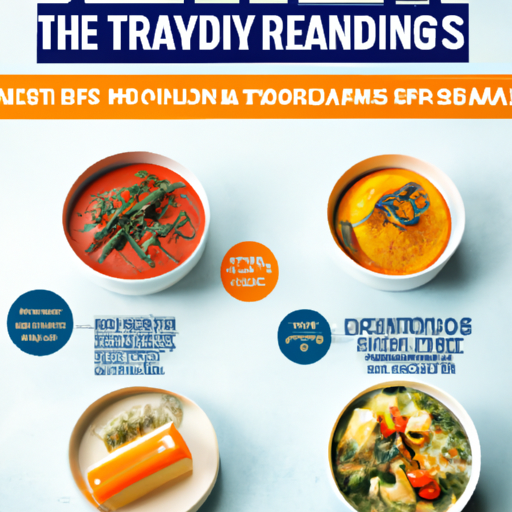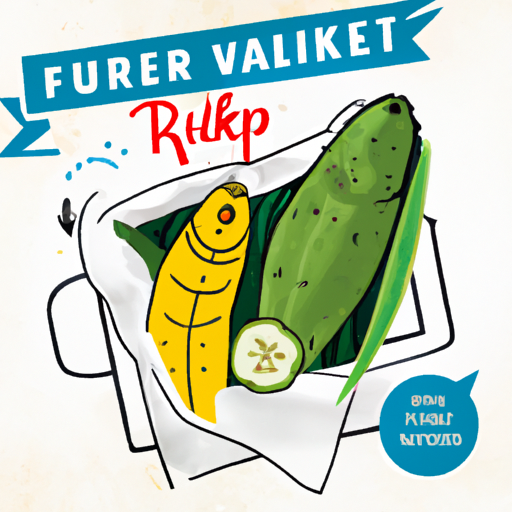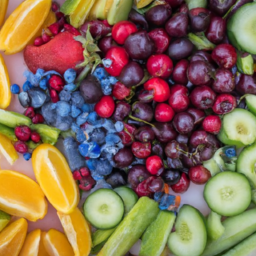Consumer Food Trends
Are you curious about the latest consumer food trends? Well, look no further! In this article, we will explore the exciting world of culinary trends that are shaping the way we eat. From plant-based diets taking center stage to the rise of sustainable and locally sourced ingredients, we will uncover the newest and most popular food trends that are making waves in the industry. Whether you are a food enthusiast or simply looking to stay ahead of the curve in your dining experiences, this article has got you covered. So, grab a snack and get ready to tantalize your taste buds with the hottest consumer food trends of the moment!

Table of Contents
1. Plant-Based Diets
Sustainable food choices
In recent years, there has been a significant increase in the number of people adopting plant-based diets. This shift is driven by various factors, one of which is the desire for sustainable food choices. Plant-based diets have been found to have a lower carbon footprint compared to diets that include animal products. By eating more fruits, vegetables, legumes, and whole grains, individuals can reduce their impact on the environment and contribute to the preservation of natural resources.
Rise of vegan and vegetarian population
The vegan and vegetarian population has been steadily growing, with more individuals choosing to adopt these lifestyles for ethical, environmental, and health reasons. Veganism, in particular, has gained popularity due to its strong stance against the use of animals for food, clothing, or any other purpose. Vegetarianism, on the other hand, allows for the consumption of certain animal products, such as dairy and eggs, while still excluding meat from the diet. The rise of these dietary choices has prompted food manufacturers to cater to their specific needs and preferences.
Demand for plant-based substitutes
As the number of people embracing plant-based diets continues to grow, there is a high demand for plant-based substitutes for animal-based products. This has led to the development and innovation of plant-based alternatives, such as plant-based milks, meat substitutes, and cheese alternatives. These products aim to provide the taste, texture, and nutritional profile of their animal-based counterparts while offering a more sustainable and ethical choice for consumers. The demand for plant-based substitutes shows no signs of slowing down, as more individuals recognize the benefits of incorporating these options into their diets.
2. Organic and Natural Foods
Growing demand for organic products
Consumers today are increasingly concerned about the quality and safety of the food they consume. This has resulted in a growing demand for organic products. Organic foods are grown without the use of synthetic pesticides, fertilizers, or genetically modified organisms (GMOs). They are also free from artificial additives, preservatives, and hormones. Many people choose organic products as they believe they are healthier, safer, and more environmentally friendly. The organic market has witnessed significant growth in recent years, with consumers willing to pay a premium for products that are certified organic.
Preference for clean labels
In addition to organic foods, consumers are also showing a preference for clean labels. Clean labels refer to food products that have a short and easily understandable list of ingredients, with no artificial additives or preservatives. Consumers are increasingly scrutinizing food labels and opting for products that are made with natural, recognizable ingredients. They want to know exactly what they are putting into their bodies and are seeking transparency from food manufacturers. The demand for clean labels has prompted many companies to reformulate their products and remove undesirable additives.
Importance of transparency in food production
Transparency in food production has become a major concern for consumers. They want to know where their food comes from, how it is produced, and whether it meets certain ethical and sustainability standards. This has resulted in an increased emphasis on food traceability and certification programs. Consumers are more likely to support brands that are transparent about their sourcing and production practices. They want to make informed choices and support companies that align with their values and priorities. Food manufacturers are recognizing the importance of transparency and are making efforts to provide consumers with the information they seek.
3. Functional Foods and Nutraceuticals
Increasing interest in functional foods
Functional foods are those that offer additional health benefits beyond basic nutrition. They are typically fortified with vitamins, minerals, antioxidants, or other bioactive compounds that promote health and well-being. There is a growing interest in functional foods among consumers who are looking to improve their overall health or target specific health concerns. Functional foods can include products like probiotics, fortified cereals, and vitamin-enriched beverages. As consumers become more health-conscious, the demand for functional foods is expected to continue to rise.
Rise of nutraceuticals market
Nutraceuticals are products that combine the benefits of food and pharmaceuticals. They are often derived from natural sources and are believed to provide specific health benefits or prevent certain diseases. The nutraceuticals market has seen significant growth in recent years, with consumers seeking these products as a means to improve their overall well-being. Nutraceuticals can range from dietary supplements like omega-3 fatty acids and herbal remedies to functional beverages and fortified foods. As consumers become more proactive in managing their health, the nutraceuticals market is poised for further expansion.
Demand for fortified and enhanced food products
In addition to functional foods and nutraceuticals, there is a growing demand for fortified and enhanced food products. These products are aimed at addressing specific nutritional needs or providing additional health benefits. For example, fortified milk may be enriched with vitamins and minerals to enhance its nutritional profile. Similarly, enhanced bread may be fortified with fiber and omega-3 fatty acids for added health benefits. Consumers are increasingly seeking out these products as a way to optimize their diets and ensure they are meeting their nutritional requirements.

4. Alternative Protein Sources
Exploration of alternative protein sources
The quest for sustainable and ethical food choices has led to an exploration of alternative protein sources. As the global population continues to grow, traditional animal-based protein sources may become unsustainable. In response, scientists and food manufacturers are looking for alternative options that can meet the increasing demand for protein without relying solely on livestock production. This has led to the exploration of protein sources such as insects, algae, and even laboratory-grown proteins. While these alternatives may seem unconventional, they offer potential solutions to the challenges of feeding a growing population.
Insect-based and laboratory-grown proteins
Insect-based proteins, such as cricket flour and mealworms, have gained attention as a sustainable protein source. Insects are rich in protein, require minimal resources to grow, and produce fewer greenhouse gas emissions compared to traditional livestock. Similarly, laboratory-grown proteins, also known as cultured or cell-based meats, offer a more sustainable and potentially cruelty-free alternative to traditional meat production. These technologies involve growing animal cells in a lab without the need for raising and slaughtering animals. While insect-based and laboratory-grown proteins are still in their early stages, they hold promise for the future of sustainable protein production.
Popularity of plant-based meat substitutes
The popularity of plant-based meat substitutes has skyrocketed in recent years. These products aim to replicate the taste and texture of meat using plant-based ingredients. Plant-based burgers, sausages, and ground meat alternatives have become increasingly common in supermarkets and restaurants. These products offer a more sustainable and ethical choice for consumers who want to reduce their consumption of animal products. Plant-based meat substitutes are constantly improving in taste and quality, appealing to both vegetarians/vegans and flexitarians looking to reduce their meat intake.
5. Sustainable and Ethical Food Choices
Concern for environmental impact of food production
Consumers today are becoming increasingly aware of the environmental impact of food production. They are concerned about issues such as deforestation, water pollution, and greenhouse gas emissions associated with conventional agriculture and livestock production. As a result, there is a growing demand for food products that are produced in an environmentally sustainable manner. Consumers are seeking out options that prioritize conservation, regenerative farming practices, and low-carbon footprint. They want to contribute to a more sustainable food system by making conscious choices that minimize harm to the environment.
Support for fair trade practices
Alongside environmental concerns, consumers are also showing support for fair trade practices in the food industry. Fair trade is a movement that aims to promote equity and sustainability in global supply chains. It ensures that producers, particularly those in developing countries, receive fair prices for their products and are provided with safe working conditions. Consumers are increasingly willing to pay a premium for products that carry fair trade certifications, as they recognize the importance of supporting ethical trade practices. Fair trade products, such as coffee, chocolate, and bananas, have gained popularity among socially conscious consumers.
Attention to animal welfare in food systems
Animal welfare is another important consideration for many consumers when making food choices. There is a growing concern for the conditions in which animals are raised and the treatment they receive within the food system. Consumers are seeking out products that are sourced from farms or facilities that prioritize animal welfare, such as certified organic or pasture-raised meats. Animal welfare labels and certifications provide reassurance to consumers, assuring them that the animals were raised in humane conditions. This attention to animal welfare reflects a shift towards more ethical and compassionate food choices.
6. Global and Ethnic Flavors
Expansion of international cuisine
The culinary landscape has become increasingly diverse, with a growing appreciation for global flavors and cuisines. Consumers are becoming more adventurous in their food choices and are eager to explore the flavors and ingredients of different cultures. This has led to an expansion of international cuisine in restaurants, grocery stores, and home cooking. From Mexican tacos to Indian curries to Japanese sushi, there is a growing demand for authentic and diverse culinary experiences. The popularity of global flavors reflects a desire for new taste experiences and an appreciation for the rich culinary traditions of different cultures.
Interest in authentic ethnic flavors
Alongside the expansion of international cuisine, there is a growing interest in authentic ethnic flavors. Consumers are seeking out products and dishes that offer an authentic taste experience, true to the traditional flavors of a particular culture or region. This has led to a demand for specialty ingredients and products from different parts of the world. Consumers are willing to experiment with new spices, sauces, and condiments to recreate the flavors they have enjoyed during their travels or in ethnic restaurants. The interest in authentic ethnic flavors represents a celebration of culinary diversity and a desire to explore the world through food.
Demand for unique flavor experiences
In addition to global and ethnic flavors, consumers are also seeking out unique flavor experiences. They want to try new and innovative combinations of tastes that go beyond the ordinary. Food manufacturers and chefs are responding to this demand by experimenting with flavor profiles, developing exciting new products, and pushing the boundaries of culinary creativity. From unexpected flavor pairings to fusion cuisine, the demand for unique flavor experiences reflects a desire for excitement, novelty, and sensory pleasure in the dining experience.
7. Convenience and On-the-Go Foods
Preference for convenient and time-saving options
In today’s fast-paced world, convenience is a top priority for many consumers when it comes to food choices. Busy schedules and a desire for instant gratification have led to a preference for convenient and time-saving options. Consumers are looking for quick and easy meals that require minimal preparation or cooking. This has resulted in the proliferation of ready-to-eat meals, pre-packaged snacks, and heat-and-eat convenience foods. Convenience is a driving factor behind the popularity of fast food chains, food delivery services, and meal kits. Consumers value the convenience of these options and the ability to enjoy a meal without the hassle of cooking from scratch.
Increase in ready-to-eat and grab-and-go products
The demand for ready-to-eat and grab-and-go products has witnessed a significant increase in recent years. These products offer consumers the convenience of quick, portable, and easily consumable meals or snacks. Ready-to-eat salads, sandwiches, and fruit cups have become popular choices for those looking for a healthy meal on the go. Snack-sized items like protein bars, yogurt cups, and trail mixes cater to busy consumers who need a quick energy boost throughout the day. The rise of ready-to-eat and grab-and-go products is driven by the need for convenience and the desire for healthy options in today’s fast-paced lifestyle.
Demand for portable and snack-sized items
In line with the preference for convenience, there is also a demand for portable and snack-sized items. These products offer consumers the flexibility to enjoy a quick bite wherever they may be. Portable foods, such as protein shakes, fruit pouches, and energy drinks, provide nourishment on the go without the need for utensils or lengthy preparation. Similarly, snack-sized items like mini muffins, single-serve chips, and portion-controlled desserts satisfy cravings without the guilt of excessive indulgence. The demand for portable and snack-sized items reflects the desire for flexibility, portion control, and on-the-go satisfaction.
8. Health and Wellness
Focus on personalized nutrition
Health and wellness have become top priorities for many consumers, leading to a focus on personalized nutrition. Each individual has unique nutritional needs, and consumers are increasingly seeking products and services that cater to their specific requirements. Personalized nutrition involves the customization of diets and nutritional plans based on factors such as age, gender, weight, and health goals. Advances in technology and nutrition science have made it easier for individuals to access personalized nutrition advice through apps, genetic testing, and tailored meal plans. As consumers become more informed about their health, the demand for personalized nutrition is expected to grow.
Desire for functional and health-enhancing ingredients
Consumers are showing a strong desire for foods and beverages that are not just tasty but also offer health-enhancing properties. They are seeking out products that are fortified with functional ingredients, such as antioxidants, probiotics, and superfoods. Functional ingredients are known for their potential health benefits, ranging from immune support to improved digestion. Many consumers are willing to pay a premium for products that include these ingredients in order to optimize their health and well-being. The desire for functional and health-enhancing ingredients reflects a proactive approach towards preventive health and the belief that food can be medicine.
Interest in holistic approach to well-being
In addition to personalized nutrition and functional ingredients, there is a growing interest in a holistic approach to well-being. Consumers are recognizing that health is not solely dependent on diet but also encompasses other lifestyle factors, such as physical activity, mental well-being, and stress management. This has led to an increased interest in holistic wellness practices, such as mindfulness, yoga, and meditation. Consumers are seeking products and services that support their overall well-being, both physically and mentally. The demand for holistic well-being reflects a shift towards a more holistic and balanced approach to health.
9. Sustainable Packaging and Food Waste Reduction
Shift towards eco-friendly packaging materials
With increasing concerns about plastic pollution and environmental sustainability, there is a shift towards eco-friendly packaging materials. Consumers are becoming more conscious of the environmental impact of packaging and are actively seeking out products that are packaged in sustainable materials. This has led to an increased use of biodegradable, compostable, and recyclable packaging options. From plant-based plastics to paper-based materials, food manufacturers are exploring innovative packaging solutions that minimize waste and support a circular economy. The shift towards eco-friendly packaging materials reflects a growing awareness of the importance of reducing waste and protecting the environment.
Efforts to minimize food waste
Food waste is a global issue that affects not only the environment but also food security and economic sustainability. Consumers are becoming increasingly aware of the scale of food waste and are looking for ways to minimize it in their own lives. This has led to a greater emphasis on meal planning, proper storage, and utilizing leftovers. Food manufacturers and retailers are also taking steps to reduce waste throughout the supply chain, through measures such as improved inventory management and donations of excess food to charitable organizations. Efforts to minimize food waste are driven by a desire to reduce environmental impact and create a more sustainable food system.
Innovations in packaging design and materials
Innovations in packaging design and materials are playing a key role in addressing both sustainability and food waste concerns. From resealable pouches to single-use portion packaging, manufacturers are finding creative ways to extend the shelf life of products and reduce waste. The use of smart packaging, such as time-temperature indicators and freshness sensors, helps consumers make informed decisions about the quality and safety of their food. Additionally, advancements in packaging materials are allowing for greater barrier properties, which can reduce the need for preservatives and extend product shelf life. Innovations in packaging design and materials are driving sustainability efforts and transforming the way we package and consume food.
10. Online and Direct-to-Consumer Food Purchases
Rise of e-commerce in the food industry
The rise of e-commerce has revolutionized the way consumers purchase food. Online shopping has become increasingly popular, offering convenience and access to a wide range of products. Consumers can now order groceries from the comfort of their homes and have them delivered directly to their doorstep. E-commerce platforms provide a variety of food options, including fresh produce, pantry staples, and specialty items. The convenience and ease of online shopping have made it a preferred choice for many consumers, especially those with busy lifestyles or limited access to physical stores.
Preference for direct-to-consumer brands
In addition to traditional online retailers, there is a growing preference for direct-to-consumer (DTC) brands in the food industry. DTC brands are companies that sell their products directly to the consumer, bypassing traditional distribution channels. By cutting out middlemen, DTC brands can offer unique products, personalized experiences, and competitive pricing. Consumers appreciate the transparency and authenticity of DTC brands, as well as the ability to support small businesses. From meal kits to specialty snacks, DTC brands are disrupting the food industry and providing consumers with new and exciting options.
Convenience of online grocery shopping
One of the major advantages of online grocery shopping is convenience. Consumers can browse and purchase products at any time, without the need to travel to a physical store. This is particularly beneficial for individuals with limited mobility, those living in remote areas, or those who simply prefer the ease of online shopping. Online grocery shopping also allows for easier meal planning and budgeting, as consumers can compare prices, access digital coupons, and track their expenses in real time. The convenience of online grocery shopping has made it a popular choice for many consumers, shaping the future of the food retail industry.
In conclusion, consumer food trends are constantly evolving in response to changing preferences, societal concerns, and advancements in technology. From plant-based diets and organic foods to alternative protein sources and sustainable packaging, consumers are driving the demand for more sustainable, ethical, and convenient food choices. The focus on health and wellness, both through personalized nutrition and holistic well-being, further highlights the importance of making informed food decisions. As we look to the future, online shopping and direct-to-consumer brands are likely to continue reshaping the food industry, offering consumers unprecedented convenience and access to a diverse range of products. It is clear that consumers’ voices and choices will continue to shape the future of the food landscape, encouraging innovation and sustainability in the pursuit of a better and more conscious food system.






